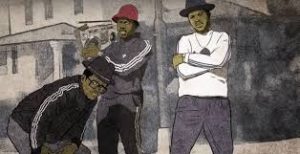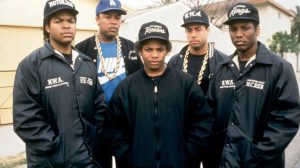Naia Saddler
Professor Markle
FYSM 212: Introduction to Hip-Hop
15 December 2019

Throughout this course, we have analyzed different arts that surround the hip hop culture. We had multiple workshops on djing, graffiti, breaking, and rapping analyzing the impact that these different art forms had on the hip hop community. Hip hop has evolved into an art that has helped communities grow. Kids were growing up in the projects with nothing, but hip hop came around and changed everything. Instead of kids gangbanging, they started to make music and go to hip hop events that were happening around the communities. Hip hop has influenced society in a positive way expanding around the world-changing lives. Kids living in the projects needed some motivation to get up and follow dreams, and hip hop helped many of those kids. Hip hop started in the “boogie-down” Bronx of New York and expanded around the world. Hip hop was seen as a negative thing to society because of the words used in the songs and the meaning of some songs. However, many young people grew up in this music and got inspired by it. In the Bronx during the 1970s, there was a lot of gang violence and it was affecting many lives. But hip hop changed that, it brought the kids who were joining gangs together. They all used to gather at different hip hop events. Just like any other art, hip hop is considered an art and it has influenced many lives.
There was also a lot of influential rappers in the hip hop world that changed many lives. With those rappers being around, it brought change to these communities and projects. Gangs were taking over New York, but with the influential DJ’s and MC’s, the gang violence started to decrease. From the assigned readings that we read this semester, I learned that hip hop is influential in different ways. In fact, hip hop brought communities together to have fun rather than pushing communities away from each other. MC’s started to influence the club scenes in the Bronx, and many people started to fall in love. Club scenes were never really a thing in the ’80s until hip hop came around. MC’s were the rappers who would be beside the Dj booth interacting with the crowd.
DJ Influences
DJ Grandmaster Flash, Afrikka Bambaataa, and DJ Kool Herc influenced the young crowd growing up in the Bronx. These DJ’s grew up in the slums of New York, but when hip hop came around, the party scene started to fluctuate. These DJ’s brought the different communities from New York together for club events. Hip hop started with the DJ’s and slowly moved to breakin’. At the club scenes, kids would have dance battles. Breaking was a way of bringing the competitive crowd together to showcase skills. In the ’80s and ’90s, there weren’t opportunities to travel around the world to breakdance and battle. But, in this generation now, there are multiple dance groups following dreams and traveling the world.
MC’s started to influence the club scenes in the Bronx, and many people started to fall in love. Club scenes were never really a thing in the ’80s until hip hop came around. MC’s were the rappers who would be beside the Dj booth interacting with the crowd. In the novel, “Book Of Rhymes: The Poetics of Hip Hop, Adam Bradley discussed the different techniques and skills needed for rap. Bradley dives deep into the rhythm making. Kids would have fun doing making rhymes and battling each other. Bradley talks about how poetry was where it all started. People would speak poetry to different beats to flow. Essentially rap is poetry. Bradley says, “Beat is something we talk about in both rap and literary verse, but in strikingly different ways” (Bradley, 10). The beat is what should flow the smoothest along with the rap. In chapter 2 Bradley talks about rhyming and its importance. Rhyming is important because it makes the song sound fresh and clean. Many kids started to rap because it was an expression. Rap in the ’80s and ’90s was looked at as bad toward the guardians of the kids listening.
Graffiti
Graffiti was another component of hip hop that influenced the young crowd in positive and negative ways. Graffiti was a form of hip hop because it originated from the Bronx, New York. There would be tags in different hoods and on the subways of New York. There would groups of kids going to different areas in New York spraying. For years Graffiti was looked at as illegal, but Graffiti is an art that is underrated. Just like rap, djing, and breaking, graffiti is an art that influenced communities. All of these arts brought communities together to get rid of gang violence and violence in general. Graffiti was a way for these kids to tag their territories whether it be on the side of a train or on a random brick wall somewhere in the Bronx. The quote that introduces chapter 8 in “Can’t Stop Won’t Stop” says, “Pop artists made art out of pop culture. These tough kids are reversing the process, making pop culture out of art” (Levin, 141). This quote is telling me that these kids changed the look on what graffiti was looked at as. They took it and made it an outlet for them. As graffiti was evolving, dance battles, MC’s started to evolve with Djing. When Dj’s started to evolve the MC’s gave a new flavor to the parties.
Los Angeles Scene

The music that we were assigned to listen to was a variety of different music. Listening to this music brought back the 80s and 90s feels that the clubs used to have. This music also had a funky and groovy mood put into it. Hip hop was not only for club scenes and party scenes, but it was apart of the political world. In New York, the hip hop scene was well known, but not only was it well known in New York, but it also expanded to Los Angeles, California. In the 1980s and 1990s, there was not just gang violence, there was police brutality happening. So the rappers used their lyrics to express their feelings about the political world.
Although hip hop originated in Bronx, New York, it later expanded to Los Angeles. In Los Angeles there was a lot of political rap during the ’80s and ’90s, there was gang violence, police brutality, and racial discrimination toward the black community, so NWA a rap group from Los Angeles released a song in 1998 named, “ F**ck The Police”. This song was very controversial to society because of its lyrics. This song was aimed toward the police because there was police brutality happening in Los Angeles and nothing was being done to stop it. In Los Angeles during the 80’s and ’90s, there was gang violence, police brutality, and racial discrimination toward the black community. For years the police have been killing unarmed black men, but nobody was speaking up, so this group used their anger and hurt in this song. When creating music, in general, it is an art, but you can use it in many different ways. When the fans are listening to this music they relate to it in some way. For example, when Ice Cube says, “A young n****a got it bad ’cause I’m brown”, he is expressing his anger toward the police because they are targeting the black crowd. This song impacted the hip hop culture by bringing the black community together to vent with the song.
Conclusion
Hip hop globally has changed the world in a positive way depending on the way it is used. The lyrics that you use in a song can affect the way someone perceives the song. For example, in this song, there is a lot of curse words, but the meaning behind the song is impactful. In this video, two young men by the names of Duan Myko and Colin Byrd expressed the impact that hip cop could have on music depending on the way it is used. If hip hop were to impact society in a positive way, the song lyrics would have to be inspiring and dream chasing. On the other hand, there are songs that are impacting society in a bad way. There are kids who look up to a lot of these rappers. The lyrics and message behind the song are the most important.
The rappers from back then to now have drastically changed because of the era that we are living in now. The environment is another factor that plays into the making of hip hop music. For instance, in this generation today, young kids are rapping and it’s easier for them to access the resources for making the music. The lyrics in a lot of these songs today are not really meaningful, but there are some artists that rap about real-world problems. But there are rappers that rap about sex, drugs, and violence, but it attracts the crowd in this day and age. In conclusion, hip hop has globally impacted communities in positive ways and negative ways depending on the message and background story of the song.
Bibliography
CHANG, JEFF. 2005. CAN’t STOP WON’t STOP. New York: St. Martin’s Press.
Fricke, Jim, and Charlie Ahearn. 2002. Yes, Yes Y’all. Reading, Mass.: Perseus Press.